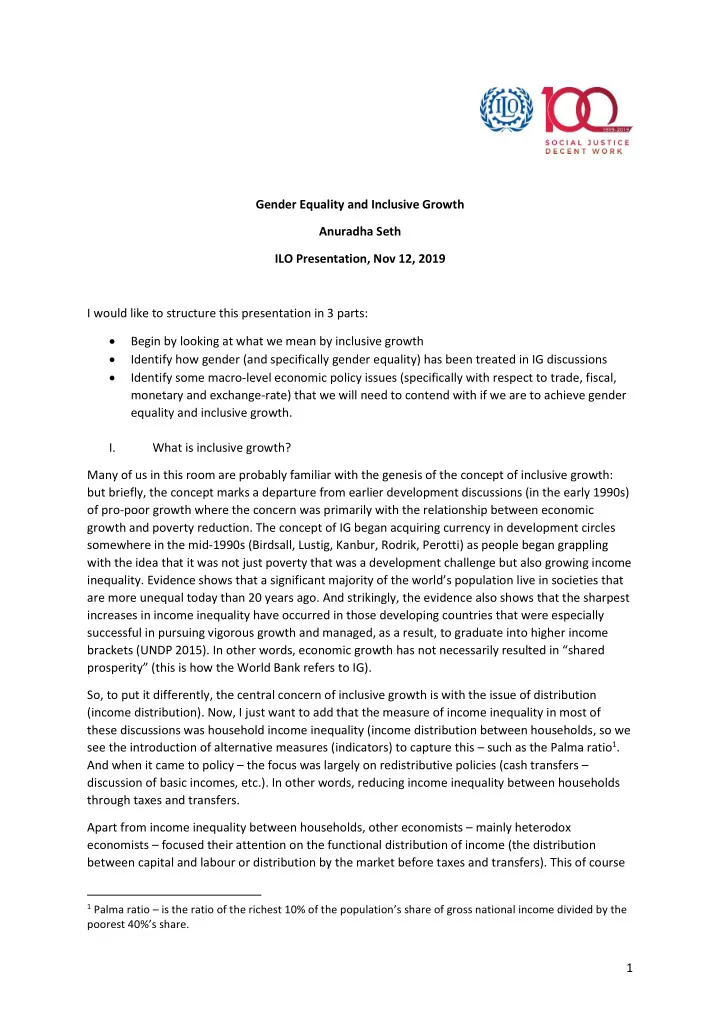

Gender Equality and Inclusive Growth Anuradha Seth ILO Presentation, Nov 12, 2019 I would like to structure this presentation in 3 parts: Begin by looking at what we mean by inclusive growth Identify how gender (and specifically gender equality) has been treated in IG discussions Identify some macro-level economic policy issues (specifically with respect to trade, fiscal, monetary and exchange-rate) that we will need to contend with if we are to achieve gender equality and inclusive growth. I. What is inclusive growth? Many of us in this room are probably familiar with the genesis of the concept of inclusive growth: but briefly, the concept marks a departure from earlier development discussions (in the early 1990s) of pro-poor growth where the concern was primarily with the relationship between economic growth and poverty reduction. The concept of IG began acquiring currency in development circles somewhere in the mid-1990s (Birdsall, Lustig, Kanbur, Rodrik, Perotti) as people began grappling with the idea that it was not just poverty that was a development challenge but also growing income inequality. Evidence shows that a significant majority of the world’s population live in societies that are more unequal today than 20 years ago. And strikingly, the evidence also shows that the sharpest increases in income inequality have occurred in those developing countries that were especially successful in pursuing vigorous growth and managed, as a result, to graduate into higher income brackets (UNDP 2015). In other words, economic growth has not necessarily resulted in “ shared prosperity ” (thi s is how the World Bank refers to IG). So, to put it differently, the central concern of inclusive growth is with the issue of distribution (income distribution). Now, I just want to add that the measure of income inequality in most of these discussions was household income inequality (income distribution between households, so we see the introduction of alternative measures (indicators) to capture this – such as the Palma ratio 1 . And when it came to policy – the focus was largely on redistributive policies (cash transfers – discussion of basic incomes, etc.). In other words, reducing income inequality between households through taxes and transfers. Apart from income inequality between households, other economists – mainly heterodox economists – focused their attention on the functional distribution of income (the distribution between capital and labour or distribution by the market before taxes and transfers). This of course 1 Palma ratio – is the ratio of the richest 10% of the population’s share of gross national income divided by the poorest 40%’s share. 1
was the concept of distribution that concerned early classical economists. And if we are familiar with Piketty, he uses the concept of pre distribution. So what has been happening to the wage share of GDP? Well, the data is simply striking: Labour shares have been declining on average across the developing world since the early 1990s. For the developing country group as a whole, average labour shares went from 52.6 per cent in the early 1990s to 48.9 per cent in the 2010s, for an average decline of 3.7 percentage points. Labour shares decreased an average of 4.1, 3.1 and 3.2 percentage points in Africa, Asia, and Latin America and the Caribbean, respectively (Braunstein 2019). Why is it important to look at the functional distribution of income? I would argue that in the present context, there are at least 3 reasons for this: First, as I mentioned, the functional distribution of income is a key driver of household income inequality. So, any policy framework trying to reduce household income inequality must begin by looking at what is happening to the share of wages in national income. This is because we cannot sustainably reduce household income inequality without seeing what is happening to labour in the production process to begin with. Second, when we talk about the changing world of work – when we consider issues of automation, technical change, the Uberization of the economy, the “gig”economy, and the implications of these developments for employment creation, it is also important to examine what these imply for functional income distribution. To see what this implies for the wage share vs profit share. Because reducing income inequality will depend not just on employment creation but also on wage policy. Third, focusing on functional income distribution takes you to the heart of growth and distribution policy: As Kanbur puts it, distribution and growth are intrinsically linked, and individual policy instruments that influence growth can also influence distribution. In other words, we cannot assume that there is no distributional bias to growth and therefore we cannot assume an implicit separability of policy instruments between growth and distribution. As he notes, this may lead to the danger of an easy slip in the classification of policy instruments into growth instruments (such as lower tariffs, higher FDI, privatizing SOEs) and distributive instruments (such as public work programs, food subsidies, and progressive taxation). More recently, Braunstein and Seguino (2019) argue that when the labour share of income faces downward pressure, and there is slow wage growth, this constrains domestic aggregate demand and can impact the process of capital accumulation. Again, the point being made is that distribution and growth are intrinsically connected. II. Let me now turn to the issue of what these discussions of inclusive growth have to do with gender equality. And how gender has been typically addressed by IG frameworks. If you recall, I started by saying that in most instances, in so far as income inequality is generally considered in IG discussions, the focus has been on household income inequality. But, if the unit of analysis is the household, then we have actually abstracted from gender (in the sense you are not looking at women’s wages/incomes relative to men’s). So, in such discussions, gender i s not even a consideration. 2
Recommend
More recommend